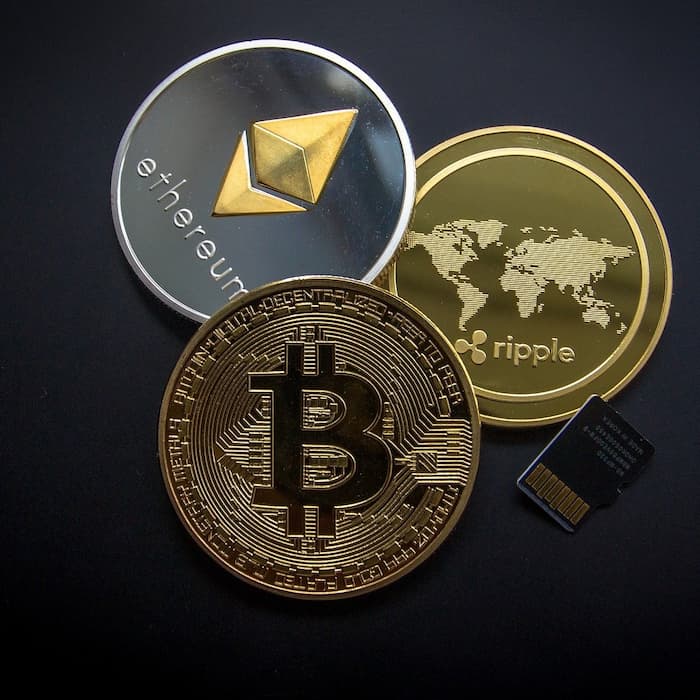Alt Investments
Market Gyrations Put Cryptos Under Cloud – How To Play Them?

Cryptocurrencies such as bitcoin have been turbulent. Prices have fallen sharply. Events reignite debate on whether these entities really can be anything other than a "play" asset for serious investors. One firm has even built a product with gold in it to reduce volatility. We explore developments.
Two years ago in the midst of the pandemic bitcoin traded at
£7,521 ($9,260). A year later it fetched £33,188 and yesterday,
it changed hands at £23,950. With recent choppy price action,
many investors will only want cryptos to be a small part of any
portfolio. But the passage of time suggests that these assets
aren’t going away.
Even so, the slide in recent weeks might dent confidence
in cryptos as being effective at protecting wealth in
times of high inflation. The jury is out. What should investors
do?
“This volatility once more underscores our view that while
historical correlations between digital assets and equities have
been low on average, these tend to spike in times of risk-off,
often resulting in outsized drawdowns for cryptos relative to
equities in risk-off times. We therefore view cryptos primarily
as return enhancers in a portfolio, rather than a safe-haven
asset. For now, headwinds are likely to persist and a quick
reversal is unlikely,” Sipho Arntzen, next generation research
analyst, Julius
Baer, said in a recent note.
“Digital assets have undoubtedly benefited from the low interest
rate, high liquidity environment in recent years, with the
reversal of the trend likely to remain a strong top-down driver
of the asset class going forward. This recent sell-off once more
reinforces our view that digital assets behave very much like
risky assets rather than safe-haven assets seeking to diversify a
portfolio,” Arntzen continued.
“While historically correlations between digital assets and
equities have been low on average, they tend to spike around
risk-off events, often resulting in digital assets falling more
than equities, as has been demonstrated recently by markets. For
now, headwinds are likely to persist and a quick reversal is
unlikely. Another development also weighing on cryptos is the
recent incident where the stablecoin Terra USD (UST) lost its 1:1
peg to the US dollar,” the analyst said.
Fancy some gold with that?
This concern that bitcoin doesn’t cut it as an inflation hedge or
portfolio protector is serious, but what happens if investors
blend it with something that does boast such qualities, such as
gold? UK-based ByteTree, an asset manager
business, has helped to do just that. In April it celebrated the
launch that month of the listing of the 21Shares ByteTree BOLD
ETP on the SIX Swiss Exchange.
This was the world’s first exchange traded product that combines
bitcoin and gold, its makers said. (ByteTree provides digital
asset data, fundamentals, technicals and crypto research and
analysis.)
Known as BOLD for short, the offering’s main gaol is to protect
against inflation via risk-adjusted exposure to bitcoin and gold
with assets weighted in inverse proportion to their risk. The
index tracks a customised benchmark/index comprising bitcoin and
gold, rebalanced once a month. The weighting at launch is 18.5
per cent bitcoin and 81.5 per cent gold. The less volatile asset
gets the higher weighting, and these are adjusted to smooth and
enhance combined returns over time.
Gold has historically performed well in “risk-off” economic
environments, while bitcoin has performed well in “risk-on”
economic environments, ByteTree argued in a note.
“In a time of rising structural inflation and heightened
geopolitical risk, we believe this can act as an important risk
and return diversifier in a balanced portfolio,” Charlie Morris,
CIO and founder of ByteTree, said.
Adding gold to the menu might make bitcoin more digestible for
skittish investors.
Over at UBS, the Swiss bank sounded a sceptical note
today.
“As the monetary regime that fueled the crypto rally unwinds, we
think investors should avoid trying to call a bottom on these
highly speculative assets. At present, we see more attractive
options for portfolio hedges, such as via healthcare and
commodity exposure, and also other ways to take on portfolio
risk, such as by tilting equity allocations toward value and the
energy sector, or via alternative assets," Mark Haefele,
chief investment officer at UBS Global Wealth Management,
said.
Whatever doubts remain, it appears that innovation pushes ahead
and cryptos push into mainstream financial areas.
Japanese banking group Nomura has entered the cryptos derivatives
space, for example.
“Nomura has launched Bitcoin OTC derivatives with Bitcoin
non-deliverable forwards and non-deliverable options for clients
in Asia out of Singapore. We also have the capability to offer
Bitcoin futures and options trading, with such trades executed
this week on the CME with Cumberland DRW, marking the first
digital asset trades for Nomura,” Rig Karkhanis, head of Global
Markets, Asia ex-Japan, Nomura, said.
“Digital assets have come a long way in the past several years,
with infrastructure growing to keep pace with investor interest.
Working with institutional-grade counterparties will allow us to
scale into the increasing demand from our clients. Options enable
investors to trade volatility directly and protect against
downside risks in the crypto market,” Karkhanis said.
He’s certainly right that investors will want to hedge volatility
if they can, and others might be willing to shoulder it. Where
different risk appetites exist, capitalism follows. Maybe what we
are seeing is the maturation of a market figuring out new ways,
or riffs on old tunes, in how to handle the ups and downs of a
new field of commerce.
And maybe such tales remind us that gold isn’t going away as a portfolio toolkit, either.
